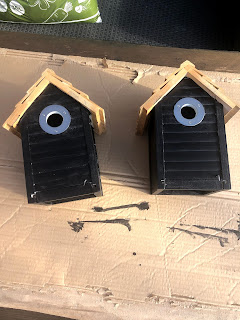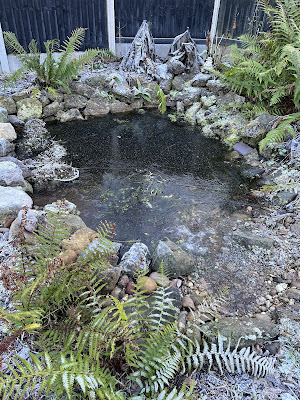Weeds
Recently I enrolled on an RHS Level 2 in Practical Horticulture and we have been learning about weeds. Apart from the Dandelion I haven't really held them in high regard. However, adjusting my mindset and thinking of them as plants in the wrong place, has helped a bit.
Learning the Botanical names for these was a challenge as weeds aren't something I've paid too much attention to. (Apart from pulling them out of the ground and fighting a losing battle). But now that I have learn't them, i've started noticing weeds more and the types of habitats that they grow in. Yes, i've become that irritating person* who can spot a plant a mile off and identify it in Latin. (*sarcasm, i'm actually rather happy about this development)
It's not just the Genus and species i've been paying attention to. It's been their preferred environment and their life-cycle. With this knowledge I can (hopefully) learn how to control them more successfully in my own space. Whilst I do like to steer clear of resorting to chemical control, my new found knowledge should make it easier for me to avoid the back-breaking work of pulling weeds by hand.
Take number 10 below for instance. This is all over the garden most of the year. I generally ignore it as it's proven challenging to control. Also, on balance it doesn't irritate me too much. If I was on top of it using the sporadic pull method I've become accustomed to, I'd have no time for living. Now, knowing this is an Ephemeral plant, that it reproduces via seed, and not rhizomes or stolons, I can adjust my control measures.
Instead of pulling it out of the ground or digging over the flower bed, I can mulch with bark or remove the plant from the surface of the soil using a Dutch hoe. I will then be denying it the perfect reproduction conditions down the road. Disturbing the soil and turning it was providing the seeds it had dropped during one of its many life-cycles, the ideal growing conditions to reproduce. I was basically doing everything wrong and making more work for myself!
Learning the Botanical names for these was a challenge as weeds aren't something I've paid too much attention to. (Apart from pulling them out of the ground and fighting a losing battle). But now that I have learn't them, i've started noticing weeds more and the types of habitats that they grow in. Yes, i've become that irritating person* who can spot a plant a mile off and identify it in Latin. (*sarcasm, i'm actually rather happy about this development)
It's not just the Genus and species i've been paying attention to. It's been their preferred environment and their life-cycle. With this knowledge I can (hopefully) learn how to control them more successfully in my own space. Whilst I do like to steer clear of resorting to chemical control, my new found knowledge should make it easier for me to avoid the back-breaking work of pulling weeds by hand.
Take number 10 below for instance. This is all over the garden most of the year. I generally ignore it as it's proven challenging to control. Also, on balance it doesn't irritate me too much. If I was on top of it using the sporadic pull method I've become accustomed to, I'd have no time for living. Now, knowing this is an Ephemeral plant, that it reproduces via seed, and not rhizomes or stolons, I can adjust my control measures.
Instead of pulling it out of the ground or digging over the flower bed, I can mulch with bark or remove the plant from the surface of the soil using a Dutch hoe. I will then be denying it the perfect reproduction conditions down the road. Disturbing the soil and turning it was providing the seeds it had dropped during one of its many life-cycles, the ideal growing conditions to reproduce. I was basically doing everything wrong and making more work for myself!
Common weeds
| ||||||
No
|
Botanical name
|
Common name
|
Life cycle
|
Means of spread
|
Control
|
Illustration
|
1
|
Bellis perennis
|
Daisy
|
Perennial
|
Seeds, Stolons
|
Dig, selective chemical (2,4-D)
| |
2
|
Capsella bursa pastoris
|
Shepherds purse
|
Ephemeral
|
Seeds
|
Hoe, contact chemical (pelargonic acid)
| |
3
|
Senecio vulgaris
|
Groundsel
|
Ephemeral
|
Seeds
|
Dig, hoe, systemic chemical (glyphosate)
| |
4
|
Taraxacum officinale
|
Dandellion
|
Perennial
|
Seeds
|
Dig, deadhead, systemic chemical (glyphosate)
| |
5
|
Urtica dioica
|
Nettle
|
Perennial
|
Seeds, Stolons
|
Dig, hoe, systemic chemical (glyphosate)
| |
6
|
Poa annua
|
Annual meadow grass
|
Annual
|
Seeds
|
Dig, selective chemical (2,4-D)
| |
7
|
Ranunculus repens
|
Creeping buttercup
|
Perennial
|
Seeds, Stolons
|
Dig, hoe, systemic chemical (glyphosate)
| |
8
|
Plantago major
|
Plantain (Ribwort)
|
Perennial
|
Seeds
|
Dig, selective chemical (2,4-D)
| |
9
|
Aegopodium podagraria
|
Ground elder
|
Perennial
|
Rhizomes
|
Dig, mulch, systemic chemical (glyphosate), residual chemical (glyphosate/diflufenican
| |
10
|
Cardamine hirsuta
|
Hairy bittercress
|
Ephemeral
|
Seeds
|
Hoe, mulch, contact chemical (acetic acid)
| |
11
|
Elymus repens
|
Couch grass
|
Perennial
|
Rhizomes
|
Dig, mulch, systemic chemical (glyphosate)
| |
12
|
Stellaria media
|
Chickweed
|
Ephemeral
|
Seeds
|
Hoe, mulch, contact chemical (acetic acid)
| |
13
|
Veronica persica
|
Speedwell
|
Annual
|
Seeds
|
Dig, hoe, mulch, selective chemical (2,4-D)
| |
14
|
Rumex obtusifolius
|
Dock
|
Perennial
|
Seeds
|
Dig, systemic chemical (glyphosate)
| |
15
|
Equisetum arvense
|
Horsetail
|
Perennial
|
Spores, Rhizomes
|
Dig, systemic chemical (glyphosate), residual chemical (glyphosate/diflufenican)
To be honest a nuclear attack isn't going to irradiate this as its roots travel up-to 2 metres below the soil surface. Bad news for the Allotment.
| |


















Comments